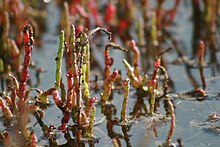Sarcocornia
| Sarcocornia | |
|---|---|
 |
|
| Sarcocornia quinqueflora | |
| Scientific classification | |
| Kingdom: | Plantae |
| (unranked): | Angiosperms |
| (unranked): | Eudicots |
| (unranked): | Core eudicots |
| Order: | Caryophyllales |
| Family: | Amaranthaceae |
| Subfamily: | Salicornioideae |
| Genus: |
Sarcocornia A.J.Scott |
| Species | |
|
ca. 30 species, see text |
|
ca. 30 species, see text
Sarcocornia is a genus of flowering plants in the amaranth family, Amaranthaceae. They are known commonly as samphires, glassworts, or saltworts. The genus has a cosmopolitan distribution, and is most diverse in the Cape Floristic Region of South Africa.
The species of Sarcocornia are perennial herbs, subshrubs or shrubs. They are taking an erect or prostrate, creeping form. The new stems are fleshy and divided into joint-like segments. Older stems are woody and not segmented. The oppositely arranged leaves are borne on fleshy, knobby petioles, their base decurrent and connate (thus forming the segments), the blades forming small, triangular tips with narrow scarious margin.
The terminal or lateral inflorescences are spike-like, made up of joint-like segments with tiny paired cymes emerging from the joints. Each cyme consists of three (rarely five) flowers completely embedded between the bract and immersed in the fleshy tissue of the axis. The flowers of a cyme are arranged in a transverse row, the central flower separating the lateral flowers, with tissue of the axis between them. The hermaphrodite or unisexual flowers are more or less radially symmetric, with a perianth of three or four fleshy tepals connate nearly to the apex, one or two stamens, and an ovary with two or three stigmas.
The perianth is persistent in fruit. The fruit wall (pericarp) is membranous. The vertical seed is ellipsoid, with light brown, membranous, hairy seed coat, the hairs can be strongly curved, hooked, or conic, straight or slightly curved. The seed contains no perisperm (feeding tissue).
The basic chromosome number is x=9. The species are diploid (18 chromosomes), tetraploid (36), hexaploid (54), or octoploid (72).
...
Wikipedia
